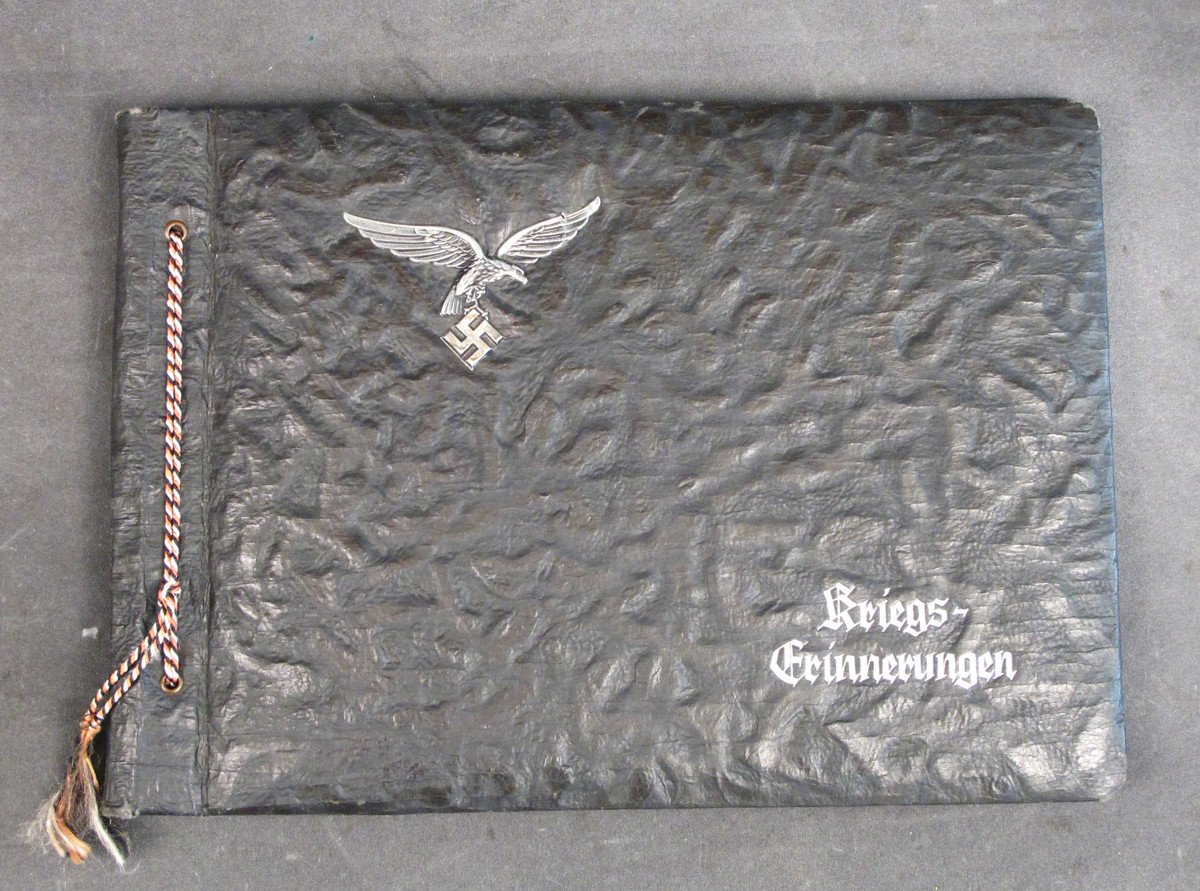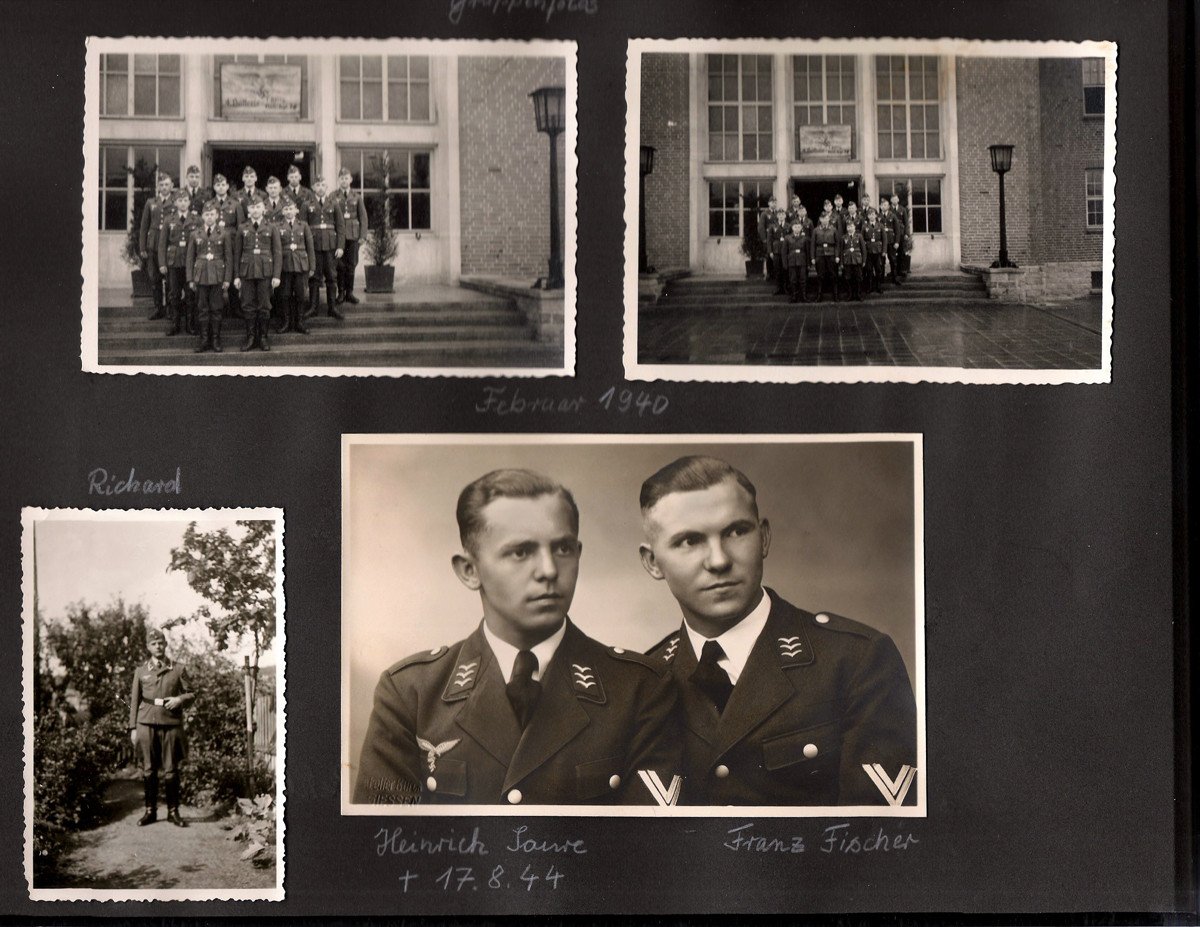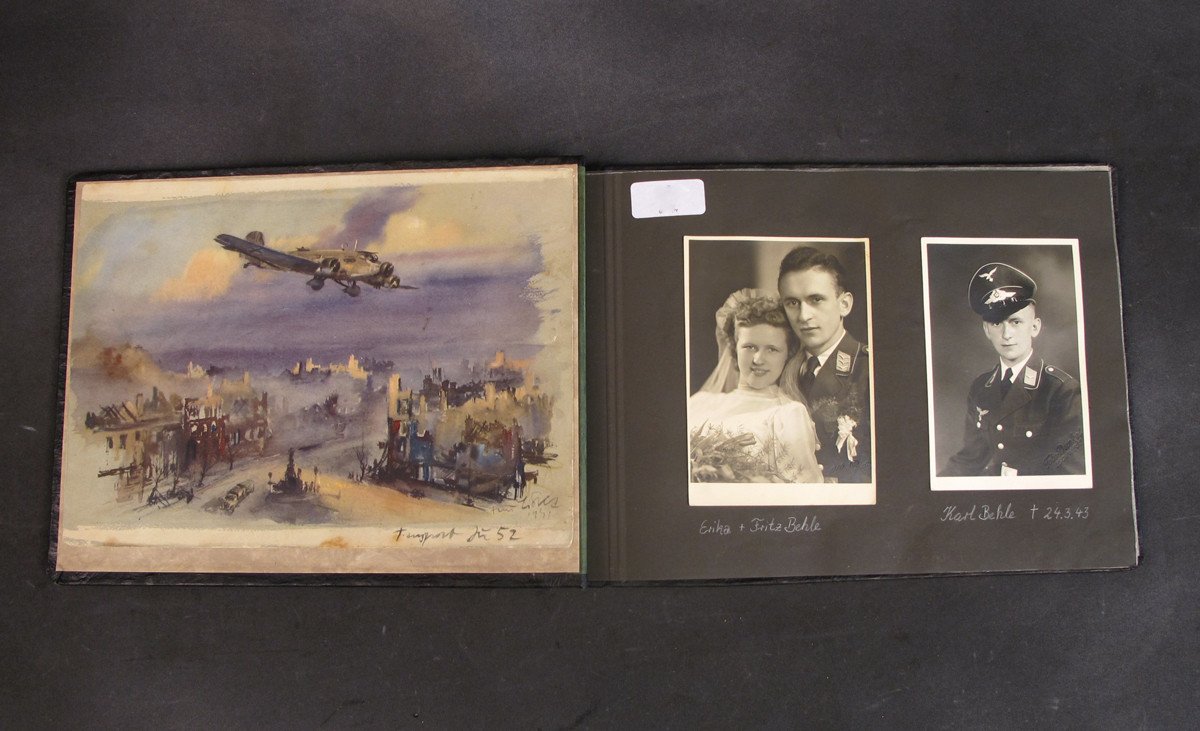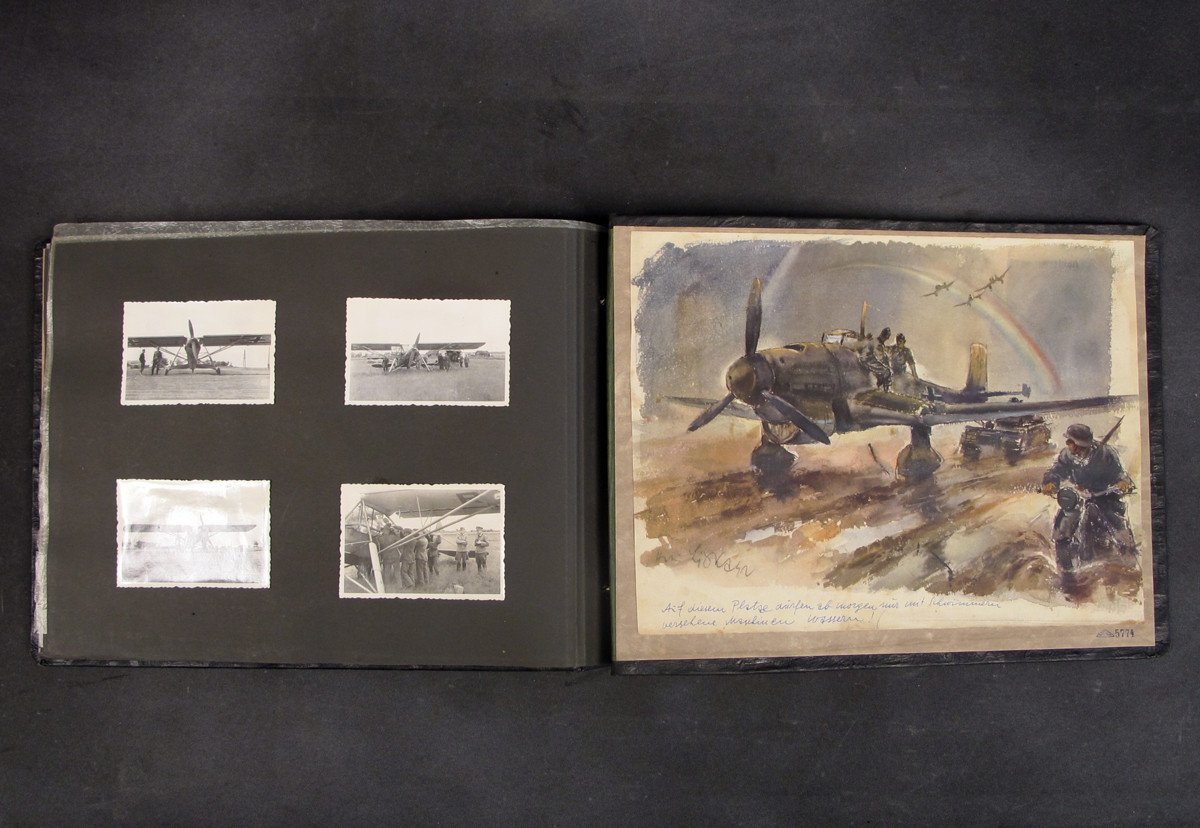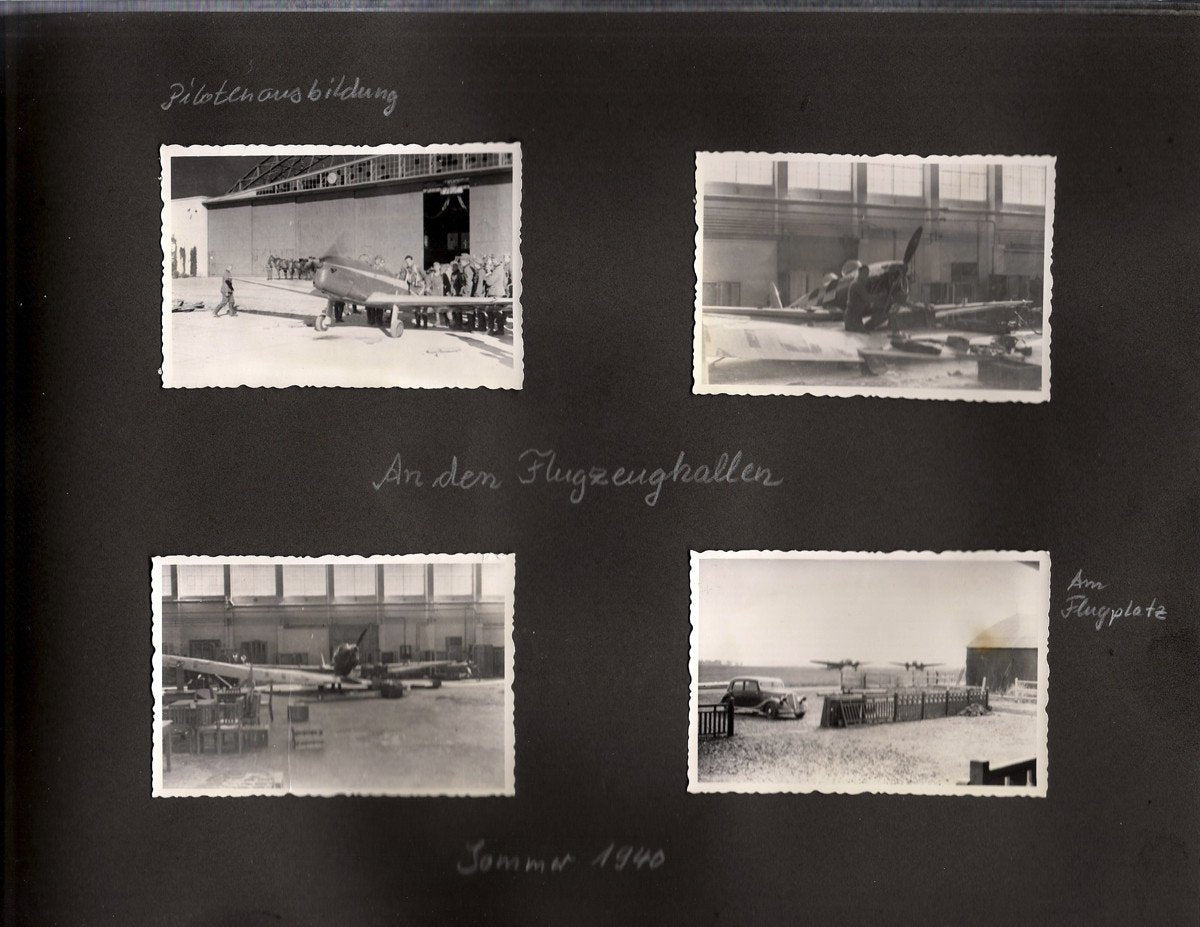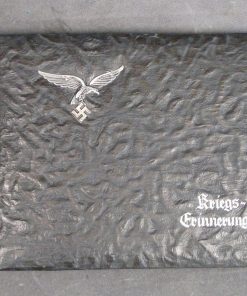Original German WWII Luftwaffe Airman Personal Photo Album Original Items
$ 1.195,00 $ 298,75
Original Item: A wonderful, carefully assembled collection of professional photographs and personal snapshots from WW2. It is the album of Obergefreiter (USAAF: Corporal; RAF: Leading Aircraftsman) Fritz Behle, and is concentrated in 1940. Photographs are about evenly divided between people and planes, although most of the aircraft photographs also feature Behles comrades.
The album cover is an attractive, deeply textured leatherette with a finely detailed Luftwaffe eagle in the upper left and the words Kriegs Erinnerungen (War Memories) in the lower right.
The very first image is the wedding portrait of Obergefreiter Behle and Erika, his bride. Fritz looks very young and innocent. Joining them on this page in a formal portrait is Flieger Karl Behle, with a crucifix symbol and date, indicating that Karl was killed on that date. He, too, looks young and innocent.
The album features numerous photographs of German aircraft of the time, including the Stuka, which is captioned with such aircraft the French and English have nothing to oppose us. Sieg Heil. The young airmans pride is undeniable in numerous captions.
Other aircraft represented are Ju 52s (Aunt Ju), He 111s, other Heinkels, Dorniers, an Me 109, Storches and other, earlier observation planes, and, perhaps most interesting, a British Wellington bomber repainted with German identification. The Wellington is captioned We also had captured English aircraft.
Crash-landed aircraft are shown in significant numbers. The landing strip is apparently grass, and the crashed aircraft, most in pretty good shape, show long skid marks up to their stopping point. What looks like an aircraft junkyard is also shown in a number of shots, with a variety of different recognizable aircraft.
Another most interesting photograph is a close-up of a He 111 with a complete cable cutter assembly in place. Design details, structure, and support assemblies are clearly represented. In researching the album, the only other photographs of the cable-cutting Heinkels we could find are of an aircraft crash-landed in the UK.
The end papers of the album are of special interest. They are prints of watercolors by the famous German artist Hans Liske. Liske was born in Vienna in 1907 and was educated as an accountant, but he soon took an interest in art. A gift of art supplies from an American got him started as an illustrator and graphic artist. His work during WW2 is among the most compelling to come out of the Third Reich. After the war, he worked as an artist for Daimler-Benz, and became internationally known for his autoracing images. He was also soon recruited to do a large range of commericial work that was recognized world-wide. The print on the inside of the front cover of the album is a page from his Skizzenbuch (Sketch Book), published during the war. It is of a Ju 52 over the ruins of an anonymous ruined city. The inside of the back cover features another page from the same book, a picture of a Stuka being pulled through a muddy track with the comment that only planes equipped with floats are allowed to touch down. The quality of these published prints, undoubtedly cut from the 1944 German edition of the Skizzenbuch, is so good that we thought they were original watercolors until examined under a loup.
A total of fifty-nine photographs fill this album, making it a treasure-trove of images taken from the viewpoint of a young, patriotic German airman. Historical records like this album have become priceless time capsules that provide an incomparable level of insight into the individual experience of the Second World War, now that over seventy years have passed.
Also included is an English translation of all the German writing in the album.
Fast Shipping with Professional Packaging
Thanks to our longstanding association with UPS FedEx DHL, and other major international carriers, we are able to provide a range of shipping options. Our warehouse staff is expertly trained and will wrap your products according to our exact and precise specifications. Prior to shipping, your goods will be thoroughly examined and securely secured. We ship to thousands clients each day across multiple countries. This shows how we're dedicated to be the largest retailer on the internet. Warehouses and distribution centres can be located throughout Europe as well as the USA.
Note: Orders with more than one item will be assigned a processing date depending on the item.
Before shipping before shipping, we'll conduct a thorough inspection of the items you have ordered. Today, the majority of orders will be delivered within 48 hours. The delivery time will be between 3-7 days.
Returns
The stock is dynamic and we cannot completely manage it because multiple stakeholders are involved, including our factory and warehouse. So the actual stock may alter at any time. It's possible that you may not receive your order once the order has been made.
Our policy is valid for a period of 30 days. If you don't receive the product within 30 days, we are not able to issue a refund or an exchange.
You can only return an item if it is unused and in the same state as the day you received it. You must have the item in its original packaging.
Related products
Uncategorized
Uncategorized
Uncategorized
Armored Burgonet Helmet & Polearm from Scottish Castle Leith Hall Circa 1700 Original Items
Uncategorized
Uncategorized
Uncategorized
Uncategorized
Uncategorized
Uncategorized
Uncategorized
Uncategorized
Australian WWII Owen MK1 Machine Carbine SMG Custom Fabricated Replica with Sling Original Items
Uncategorized
Angolan Rebel 1970s era 60mm Inert Display Mortar from Angolan Civil War Original Items
Uncategorized
Uncategorized
Uncategorized
Armoured Fighting Vehicles of the World: AFVs of World War One (Hardcover Book) New Made Items
Uncategorized
Uncategorized
